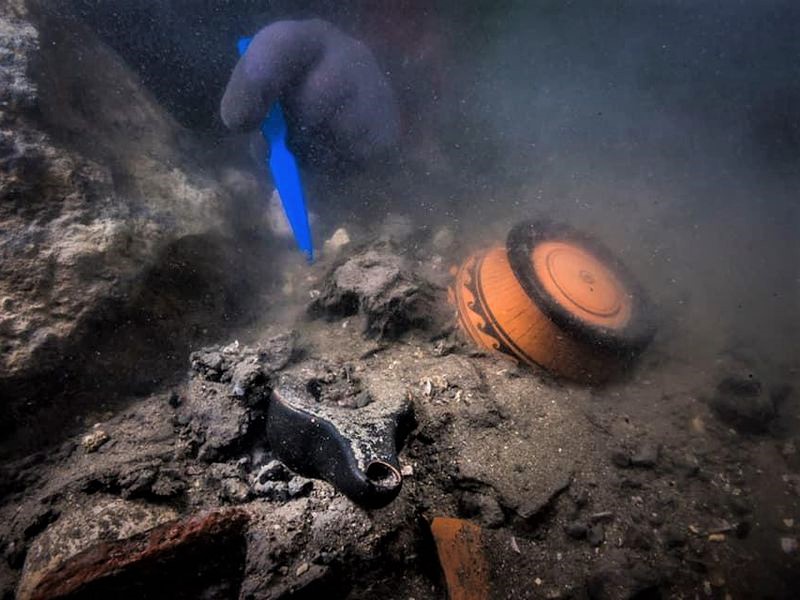
©Christoph Gerigk/Franck Goddio/Hilti Foundation
Vocabulary:
I will read the words, meanings, and sample sentences. Then, repeat after me.
- wicker /WIK-er/
- metropolis /mi-TROP-uh-lis/
- archaeologist /ahr-kee-OL-uh-jist/
- lavish /LAV-ish/
- depict /dih-PIKT/
[adjective] – made of very thin pieces of wood twisted together
I can’t believe that I just spent a huge amount on this wicker furniture!
[noun] – a very large city, often the most important city in a large area or country
Kim lives in the metropolis of Shanghai in China.
[noun] – someone who studies the buildings, graves, tools, and other objects of people who lived in the past
The archaeologist found a lion fossil in the cave.
[adjective] – large in quantity and expensive or impressive
My mom keeps a lavish collection of luxury bags and perfumes.
[verb] – to represent or show something in a picture or story
Vincent Van Gogh’s artwork Starry Night depicts a dreamy interpretation of his view while in isolation.
Article reading:
Please read the whole article. Then, I will check your pronunciation and intonation.
Greek ceramics, 2,400-year-old wicker fruit baskets, and several other archaeological treasures were discovered under the submerged metropolis of Thonis-Heracleion, in the bay of Abū Qīr. Before Alexander the Great founded Alexandria in 331 B.C.E., Thonis-Heracleion was the largest Mediterranean port in Egypt.
In cooperation with Egypt’s Ministry of Tourism and Antiquities, French marine archaeologist Franck Goddio and his colleagues at the European Institute for Underwater Archaeology (IEASM) unveiled the vessels. Remarkably, they still contain the fruit of an African palm tree, which is known as the doum nuts, and grape seeds. Goddio assumed that the fruits might have been preserved for funerary offerings since they were placed in an underground room. Close at hand, the team identified a 197- by 26-foot tumulus, or burial mound, and a lavish collection of Greek funerary stuff. “Nothing was disturbed,” Goddio clarified. “Spectacular ceremonies must have taken place there. The place must have been sealed for hundreds of years as we have found no objects from later than the early fourth century B.C.E., even though the city lived on for several hundred years after that.” Online newspaper Egypt Independent said that researchers have been studying the ancient port city since its rediscovery in 2001.
Ancient pottery, bronze artifacts, and figurines depicting the Egyptian god Osiris (also called Usir), were also discovered around the tumulus. The discovery “beautifully illustrates the presence of Greek merchants and mercenaries who lived in Thonis-Heracleion, the city that controlled the entrance to Egypt at the mouth of the Canopic branch of the Nile,” IEASM said.
In cooperation with Egypt’s Ministry of Tourism and Antiquities, French marine archaeologist Franck Goddio and his colleagues at the European Institute for Underwater Archaeology (IEASM) unveiled the vessels. Remarkably, they still contain the fruit of an African palm tree, which is known as the doum nuts, and grape seeds. Goddio assumed that the fruits might have been preserved for funerary offerings since they were placed in an underground room. Close at hand, the team identified a 197- by 26-foot tumulus, or burial mound, and a lavish collection of Greek funerary stuff. “Nothing was disturbed,” Goddio clarified. “Spectacular ceremonies must have taken place there. The place must have been sealed for hundreds of years as we have found no objects from later than the early fourth century B.C.E., even though the city lived on for several hundred years after that.” Online newspaper Egypt Independent said that researchers have been studying the ancient port city since its rediscovery in 2001.
Ancient pottery, bronze artifacts, and figurines depicting the Egyptian god Osiris (also called Usir), were also discovered around the tumulus. The discovery “beautifully illustrates the presence of Greek merchants and mercenaries who lived in Thonis-Heracleion, the city that controlled the entrance to Egypt at the mouth of the Canopic branch of the Nile,” IEASM said.
Discussion Questions:
I will read each question. Then, please answer them.
- What do you know about the ancient history of your country?
- What ancient discovery has struck you the most? Please tell me more about it.
- If you were an archaeologist, what would you focus on studying?
- What images come to your mind when you hear the word “ancient”?
- Are discoveries like this significant? Why or why not?
Summarization
Please summarize the whole article using your own words and expressions. You will have one minute to prepare before you answer.
Describe:
Please explain the definition of each word listed below based on your understanding. You can provide example sentences if needed.
- treasure
- discover
- preserved
- artifacts
- ancient